
As I write this, we have just passed the summer solstice, a time of celebration for non abusive neopagans and Wiccans: a time of human or blood sacrifice for some ritually abusive cults.
For many, awareness of ritual abuse began with the spirit cooking and pizzagate scandals, which over time have been so mangled in retelling and media mockery that one struggles to remember what was so compelling about the scandals in the first place.
Why address pizzagate over a year and a half after it broke into conscious awareness?
Recently, I found some additional information which shocked me in that it depicted so clearly the way in which pizzagate was a genuine, unintended and uncontrolled revelation which left the plutocratic elite scrambling to regain control of the narrative for at least two months. After that point, the issue was quickly muddied by disinformation, confusion, and the unavoidable fact that the vast majority of the public didn't know what they were looking at.
A year and a half later, I think that many people still do not grasp what ritual abuse is, and as a result, they are easily misled by disinformation about the issue. What do I mean by disinformation? Specifically, a focus on aesthetic over practice. Why is it harmful to focus on aesthetic instead of practice? Because in doing so, we can easily be distracted away from evidence in plain sight that we would otherwise look into further. In this way, focusing on aesthetic can be an extremely effective deflection tactic.
This post does not claim that ritual abuse does not happen in situations with Masonic/ Luciferian/ Satanic/ Kabbala-related imagery. The thesis of this piece is not meant to discount those experiences at all, but to look beyond the symbols and understand the heart of the practice, so that you the reader can more easily spot it, no matter what aesthetic it wears.
The origins and "history" of pizzagate were set out in a thoughtful manner by the founder of the r/pizzagate subreddit. That subreddit was subsequently banned within less than a month of its creation, if memory serves. The Pizzagate Wiki was likewise an incredibly valuable resource, which has repeatedly gone down and is currently unavailable, but which is at least partially accessible through archive services.
I return to their history because one of the sources compiled by the founder of the r/pizzagate sub included this thread, which was, in turn, another compilation of a massive amount of information surrounding the more easily dismissed aspects of pizzagate: namely, the Comet Ping Pong restaurant, as opposed to the actual primary source evidence provided by Wikileaks in the initial "Spirit Cooking" email that sparked people's interest in Podesta, and hence his connection to David Brock, Alefantis, his Instagram account and then Comet Pizza, in the first place.
Continuing down the well-worn pizzagate trail, though, we find mention of "artist" and "experimental musician," Arrington de Dionyso, who painted murals inside the infamous Comet Ping-Pong restaurant.
By returning to the most cliched aspects of "pizzagate," I want to show that even in these leads, evidence was missed that hinted at the shamanistic core of ritual abuse. I hope that pointing out this connection will help widen the viewpoint of those whose research on this subject ends once they find one occult symbol. Most often, there is strong evidence that is available which lends credence to the conclusion that ritual abuse is fundamentally shamanistic, but this evidence is missed because people are conditioned to look for a specific language of symbols that have nothing to do with the core of ritual abuse itself.
So, we begin with the mural painted by Dionyso in comet ping pong:

When searching for other work by Dionyso, those researchers quickly discovered more gruesome work, including the following:
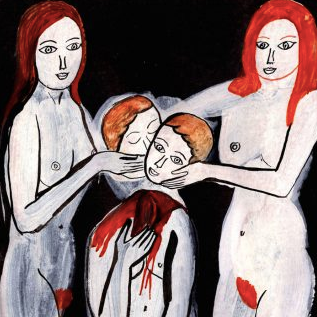
Dionyso's name is of immediate interest, in terms of the the orgiastic, ecstatic rights of Dionysus which were said to include ritualistic cannibalism amidst wild dances and ecstatic altered states.
Some context is necessary to understand Dionyso's namesake, the Greek deity Dionysus. To gain that understanding, we have to detour back to Esalen, a topic I've previously covered at length.
As part of my earlier research on Esalen, it became clear that the 'resort' and a number of related campuses have strong ties to the CIA, OSS, and Tavistock. Esalen specifically has deep connections to the birth of the Human Potential Movement, which was then tied both to the CIA and the leader of the Finders cult. As part of that research, I stumbled onto the work of John Weir Perry, which I mentioned in the last segments of my investigation of Esalen.
In that last segment on Esalen, however, I did not discuss the work of Michael Cornwall, the acolyte of John Weir Perry, who in turn had been a disciple of Carl Gustav Jung.
Michael Cornwall, that grandchild of the Jungian path, was instrumental in the work on madness conducted by Perry at Diabasis House., and is still a staff member at Esalen who conducts workshops there on "extreme states." Thus he continues the early Tavistock-linked experiments in Schizophrenia that were cited as a founding purpose of the campus. Cornwall will require a separate post to fully explore his relevance to this topic.
Cornwall, who is also a current staff member at Esalen, also refers to 'secrets in plain sight,' when writing of his 'Jungian Blasphemy' of worshipping and performing rituals to call on the 'gods behind Jung's archetypes.' Cornwall writes:
"For several years preceding that evening I had been doing magical rituals to call forth Dionysus. I had read a great deal on the cultic history and rites of Dionysus and had introduced that material into the trance sessions I described above, which as usual only intensified my dreams in that inner realm. Perry had done a remarkable presentation at U.C. Berkeley on Dionysus with Joseph Campbell and Mickey Hart of The Grateful Dead. Perry was an expert on Dionysus."
For now, a simplified version of the previously noted connections would look something like:
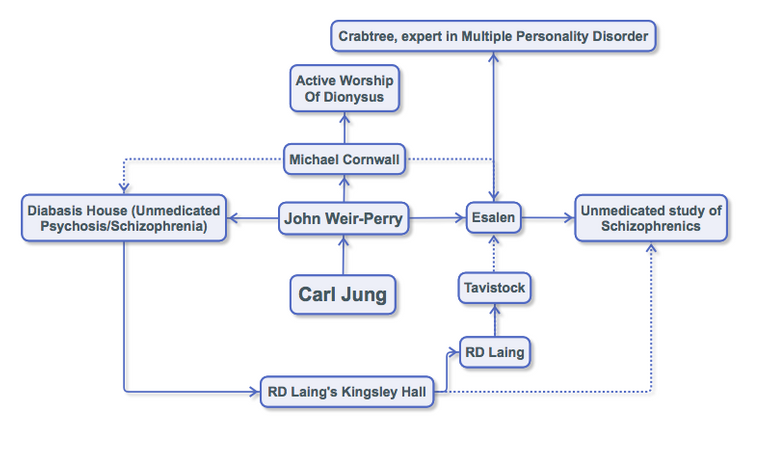
In his writing, Cornwall enthuses about the cannibalistic orgies dedicated to Dionysus, and claims that Jung had repressed his Dionysian impulses, citing his affairs and his fear of becoming 'lost to the mad God,' as did his predecessor, Nietzsche.
Unironically, he states:"Orwell famously affirmed this psychological axiom –‘To see what is in front of one’s nose needs a constant struggle." The following image is a depiction of the quartering of Pentheus/Penteo, ruler of Thebes, on the order of Dionysus. Pentheus is quartered by his mother.
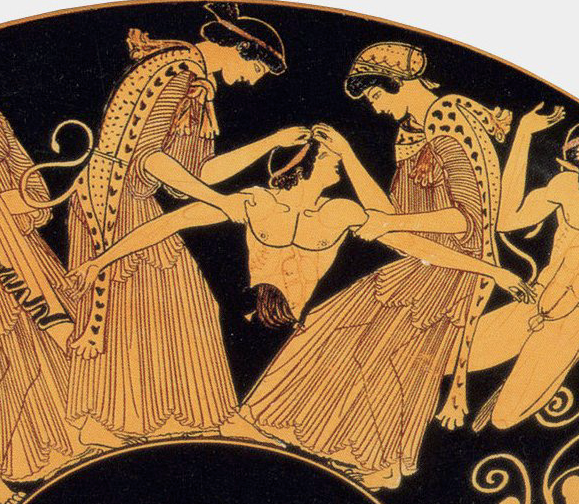
Cornwall refutes Jung's separation between an archetypal understanding of polytheistic gods and the outright the worship of them. Cornwall describes performing cultic rituals to call Dionysus forward, explicitly telling us that the ancient rites involved ritual cannibalism:
"Human sacrifice and ritual cannibalism were practiced in his rites."
Cornwall then recounts with relish his resulting dreams involving cannibalism, specifically eating the heart of another human being. Although Cornwall tells us many times that he used aspects of the original worship of Dionysus to summon the deity and classifies that worship explicitly as involving ritual cannibalism and human sacrifice, he conveniently does not specify which aspects of the ancient rites he actually used.
Cornwall's own words about the nature of Dionysus and the historic rituals dedicated to him:
"*Dionysus was frequently referred to by the ancient historians in their descriptions of his early rites throughout Asia Minor and the Mediterranean as ‘The Maneater.’ Human sacrifice and ritual cannibalism were practiced in his rites. His leopard epiphany spoke to his bloodthirsty nature as one aspect of his complex being which is also portrayed in his initiatory rites in the form of a large free standing phallos."
"No single Greek god even approaches Dionysus in the horror of his epithets. He is called the render of men, the eater of raw flesh... we hear not only of human sacrifice in his cult but also the ghastly ritual where a man is torn to pieces..as a beast of prey who eats flesh raw... the man eating sphinx reminds us vividly of Dionysus.”
“Dionysus is the god who is mad... But the God himself is not merely touched and seized by the ghostly spirit of the abyss. He, himself is the monstrous creature which lives in the depths... He is the mad ecstasy which hovers over every conception and birth and whose wildness is always ready to move on to destruction and death."
Possession in ancient times may have also been an early conception of the symptoms of multiple personality disorder and extreme dissociation. As I've previously noted, Adam Crabtree, one of Esalen's three principal figures, is a self-described expert in multiple personality disorder, and authored the book: "Multiple Man: Explorations in Possession and Multiple Personality."
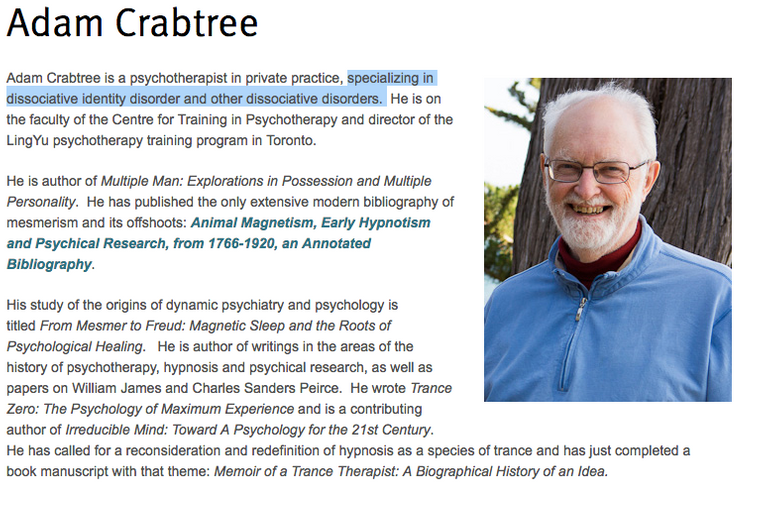
Winkelman, an academic whose work I will describe in more detail shortly, suggests that dissociation, as a biological evolutionary trait, developed specifically in relation to and as a result of Shamanistic practice - specifically spirit possession. The implications for ritual abuse in light of his theory are shocking. He states:
"The alterations of consciousness... and other aspects of shamanistic healers reflect a biological basis. A deep evolutionary basis for shamans is attested to by their virtually universal presence in the foraging societies of the historic past and evidence of an even greater antiquity to shamanism"
In other words, the dissociation that takes place in multiple personality disorder in response to ritual abuse could not have been possible if not for the ancient practice of shamanism. This places shamanistic methods not only at the core of ritual abuse but also as the genesis of dissociation itself.
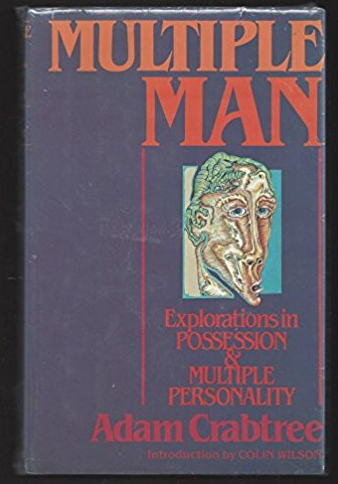
Did Michael Cornwall perform rites to Dionysus at Esalen, where one of the three leaders of the campus is a self-described expert on dissociative personality disorder, hypnosis, and trance?
While I do not intend to divert this piece into an article about Esalen, it seems incredible that a supposed hippie resort-turned yuppy-resort would be led by an expert in multiple personality and "trance hypnosis." Why is such a person involved with an institution that is simply a playground for the ultra-wealthy? Cornwall's answer is clear. He describes Esalen not as a hippie commune, but as a place to study madness, writing:
"When Richard Price was a young man, he experienced extreme states for which he was labeled schizophrenic and forcibly ‘treated’ with psychiatric medications, ECT, and insulin shock. He suffered from residual effects from this for the rest of his life... From its beginning, Esalen worked to create sanctuary for people who, like Price, experienced extreme states...Both at the institute itself and through the creation of projects like the rigorously designed, NIMH-funded Agnews Project research, Esalen helped to create the contemporary model of madness sanctuary."
Here Cornwall admits that Esalen not only studies "extreme states," but also spawned further sites of state-backed study, including the "NIMH-funded Agnew Project research."
A blog authored by John F. Callahan discusses the nature of the Gestalt practice (which he distinguishes from therapy, just as I distinguish shamanism as a method vs religions) as developed by Esalen co-founder Dick Price. Incredibly, it appears as if my previous posts on the body as the central vehicle of ritual abuse (as opposed to the mind/cognition) was far more accurate than I could have ever imagined.
"Emotion and energy mean the same thing. Emotion energizes human behavior. Emotion is embodied energy. And energy is distributed throughout the body, not just in the brain. This is in accord with our contemporary understanding that neural processing centers are distributed throughout the body — with neural networks in the genitals, the abdomen and stomach, and surrounding the heart. And trauma, for instance, results in the blockage of the flow of energy through these centers. Dick Price was influenced by the embodied psychology of Wilhelm Reich. Reich said that emotional blockages were manifested in the body. And that understanding is reflected in contemporary Gestalt Awareness Practice."
In other words, Callahan explains that a kind of awareness is distributed throughout the body in the form of neural networks. This incredible statement recognizes exactly what I argued in my article The Body And Ritual Abuse, when I suggested:
"The concept of body-as-medium is a critical aspect of ritual abuse. The mind is not accessed directly. Instead, the deeper subconscious is targeted. This bodily experience ultimately controls the formation of the mind without conscious knowledge of the individual affected, especially in childhood..."
Again: Callahan & Price recognized the fact that trauma exists locked in the body, not the mind. Possibly even more telling is Callahan's description of Gestalt practice as communal:
"[Gestalt Practice] is a communitarian practice. That is to say, [Gestalt Practice] does not depend upon the individual expertise of a professional. Rather it is based upon a communitarian field — a field of awareness, empathy, and equanimity — in order to promote transformation."
That Cornwall is a member of the staff at Esalen, studies the madness of schizophrenia (which can be understood as the dissociation involved with ritual abuse) and advocates the "authentic" worship of a god of insanity will be the subject of a future post. For now, returning to the artist Dionyso who painted the mural at Comet Ping Pong, we find references to Dionysus the god in Instagram posts of his work, as in the following:
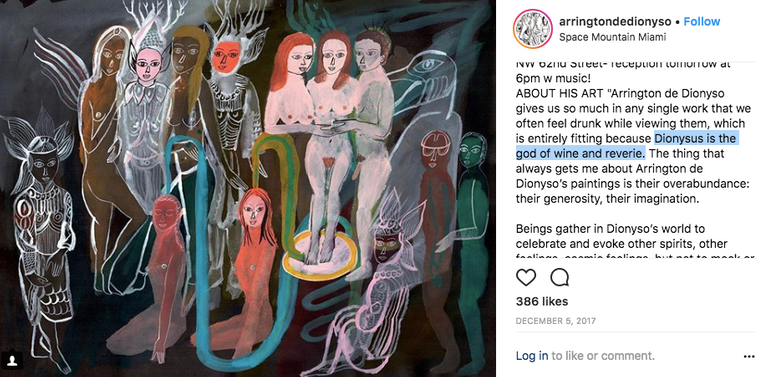
Given the cannibalistic rites of Dionysus so explicitly referred to by Cornwall, we can genuinely say that Dionyso's work had an important extra layer of significance insofar as his name's connection with the rites of Dionysus and therefore the types of acts associated with ritual abuse. This context gives added weight to his art's presence at Comet Ping Pong, but was neglected by early pizzagate researchers.
The following image by Dionyso is surreal, but evokes the image of cannibalism as well as the mingling of human and animal figures:
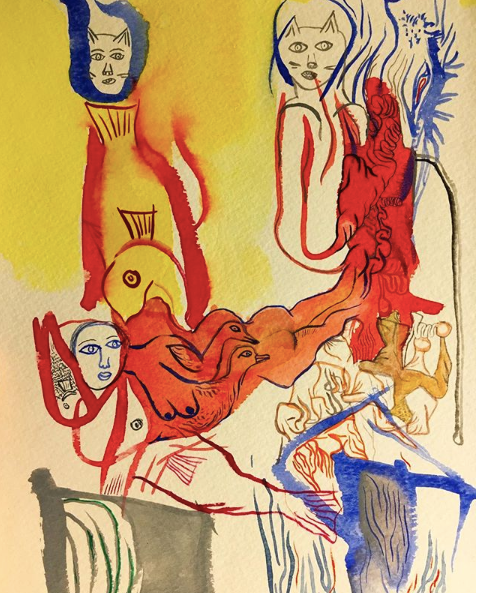
In other primitive religions, we find violent and ecstatic traditions usually associated with the notion of possession, similar to the rites described by Cornwall in tribute to Dionysus. Even in some Christian traditions, such as Pentecostal, speaking in tongues is said to occur via a possession by the holy ghost.
So what is a definition of shamanism, since we see this concept raised over and over again in connection with ritual abuse? In his work "Shamanism and the Alteration of Consciousness," Michael Winkelman writes:
"Features... occurring in hunter-gatherer societies; serious illness as part of the selection process; a calling by the spirits; a death/rebirth experience; a deliberate vision quest for spirit contact; the capacity to fly; a special relationship to animal spirits involving transformation into an animal; and the potential for malevolent use of power to cause sickness or death."
Another definition provided by Winkelman provides the following characteristics:
- Deliberate alteration of consciousness during both training and practice;
- An initiatory death-and-rebirth experience;
- An experience known as the soul journey or soul flight;
- Communal ritual activities involving chanting, music, drumming, and dancing;
- A primary source of power involving control of animal spirits;
- A belief in their ability to transform into animals;
- Professional abilities involving healing, diagnosis, divination, and assistance in hunting;
- Theories of illness involving soul loss, magical intrusion of objects, and attacks by spirits and shamans;
- A belief in their ability to do harm through sorcery.
On the universality of Shamanism, Winkelman writes: "The alterations of consciousness, soul flight experiences, spirit and animal identities, healing and divination practices, and other aspects of shamanistic healers reflect a biological basis. A deep evolutionary basis for shamans is attested to by their virtually universal presence in the foraging societies of the historic past and evidence of an even greater antiquity to shamanism."
Crucially, Winkelman actually compares shamanistic trance with hypnosis and dissociation. Through his observations we understand a level of logical reasoning behind multi-generational ritual abuse cults focused within certain families:
"Carden˜a and Krippner (2010) note many parallels between shamanic and hypnotic phenomena, including: fantasy-prone and dissociative characteristics; family tendencies in susceptibility suggestive of genetic contributions; developmental paths involving injury, illness, and trauma; a tendency for artistic production and cognitive flexibility; spontaneous out-of-body experiences; and the use of monotonous procedures that focus attention and limit conscious awareness. Dissociative experiences involving a separation of the body from the environment are a key aspect of hypnosis that promotes an engagement with an alternate reality."
I would highly suggest reading the entirety of Winkelman's paper, as it is incredibly relevant material in this discussion of ritual abuse, and its core functions.
In light of Winkelman's work it seems especially likely that early versions of what we would call ritual abuse were developed through various forms of shamanism over eons -- long before the Abrahamic traditions had been imagined much less written down. This destroys the narrative often pushed in alternative media that argues that ritual abuse stems only from the moloch-worshipping carthaginians or ancient semitic cultures. I believe that narrative has been pushed so hard amongst the independent-minded public on conspiracy forums and elsewhere specifically to prevent the wider understanding of the reality of how ritual abuse works, so that the strongest evidence of its existence can remain safely hidden in plain sight.
[Non-abusive]Shamans practices in Siberia, Image: via The Daily Mail
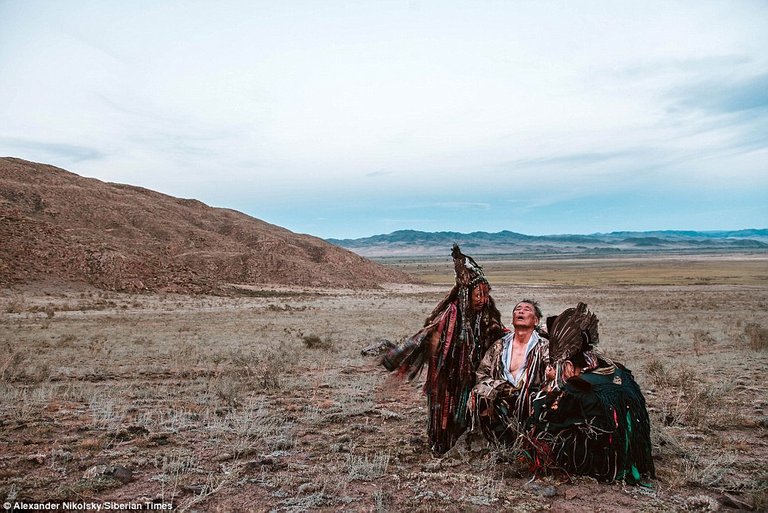
In Winkelman's definition of shamanism, he specifically states that it was the product of hunter-gatherer societies. Hunter-gatherer societies also predate the development of agriculture, city-states, written language etc, and occur globally, from the Norse, who practiced human sacrifice, to the Tibetan plateau, which included ritual cannibalism, to the rainforests of the Amazon and subsaharan Africa. As pointed out by others, there is an important differentiation between shamanism and any religion.
That shamanism is so ancient also means that the practices of cannibalism and sacrifice within those minority traditions are separate from or predate the development of agriculture and the types of sacrifice that took place as a kind of payment to deities of fertility to ensure good harvests.
A really informative example of this is the god Dionysus that we have already discussed in terms of Esalen's Michael Cornwall and Arrington Dionyso. Dionysus exists outside the "city gates" and is the personification of wilderness as well as shamanic ecstatic frenzy. He is the god of wine, and is considered a dying and rising god, but the killings done as part of his rituals were not, in my understanding, presented as an offering in order to ensure good harvest or in this case good wine. They were performed in the midst of an altered state of consciousness in an uncontrolled and spontaneous fashion.
Below: A rare Shamanic tradition is documented in Kazakhstan. Note that it involves a relatively small group of people in close contact, as opposed to a vast crowd at an execution in a city-state.
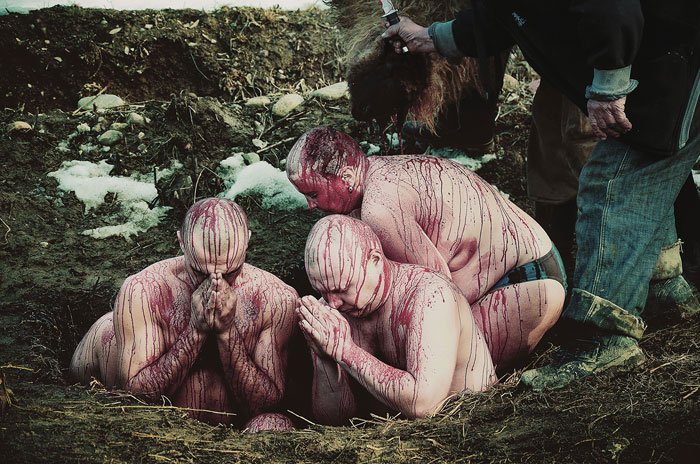
This contrasts with the ceremonialized, methodical sacrifices of the later agricultural societies who killed at regular time intervals to placate deities responsible for good harvests. These groups would not fit the nature of ritual abuse for a number of reasons. First, the sacrificial victim is often treated as a living god for a period of time before their death. If one of the major consistent goals of ritual abuse is to create alter personalities, often considered "possession" in primitive cultures - then the only person involved who could possibly be considered possessed (in the role of a living god) would not live past the ceremony.
Sacrificial executions helped rulers of early city-states to consolidate their power. Such events were not aimed at creating alter personalities in participant, as is the case in ritual abuse and to some extent (via spirit possession and other means) in shamanism. This doesn't mean that such executions were not grisly and barbaric. It is simply to say that it does not - and cannot- explain the development of ritual abuse.
Likewise, Priests conducting such sacrifices (executions) were not in a shamanic frenzy, but were methodical and repetitive, in terms of the execution itself and the ritual ceremony surrounding it - the absolute opposite of an ecstatic state. That priest would no more develop a split personality than an executioner.
Finally, the communal altered state described in the rites of Dionysus and in Winkelman's definition of shamanic traditions is completely absent from the ceremonial agricultural sacrifices of city states - even those of children, as took place in Carthage. This is important because we would not expect the audience to develop split personalities in this situation, any more than crowds watching public hangings would in later centuries.
The image below shows the spectacle of a public hanging.

Compare that with the images provided by Cornwall that tell us of Maenads ripping humans and animals to pieces with their bare hands as part of ecstatic and frenetic rites. During these smaller group events, if one or even multiple people are killed and cannibalized, the majority of the group will still survive, allowing them to develop split personalities through their direct participation in the violence. All the members of such a group would thus be more affected than if they simply witnessed a public sacrifice from a distance, and would have also likely experienced an altered state through dance, various substances, music, etc.
With all this in mind, it seems logical to conclude that the collective altered consciousness resulting from aspects of shamanism fits with the development of ritual abuse in a way that sacrifice to agricultural deities cannot. That isn't to say that over the centuries, the ritual abuse developed via shamanistic methods didn't amalgamate with later religious systems and ceremonies borne with agriculture.
Winkelman's definition of shamanism includes contact/control of animal spirits, as well as the shaman's belief that they transform into animals during rituals/trance etc. The concept of transforming into an animal is reminiscent of the widely-discussed creation of animal alters, including "beta kitten" programming. Historically, this shamanic belief seems to have been stereotyped into the European's caricature of witches' familiars.
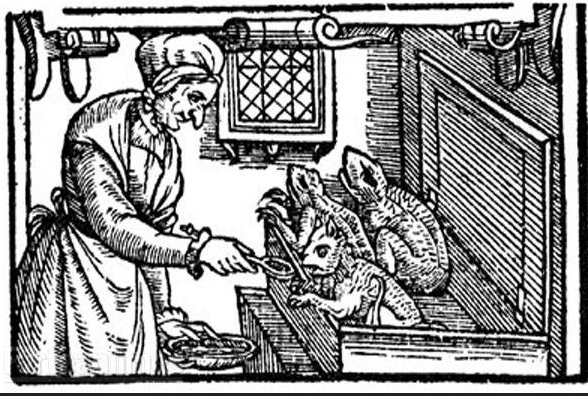
We see also animals blending with and shapeshifting into human form in Dionyso's art, and he often shows himself wearing this cat mask. In the following instagram post discussing an event with children, it appears that a child is wearing the large mask.

Dionyso with his cat mask.
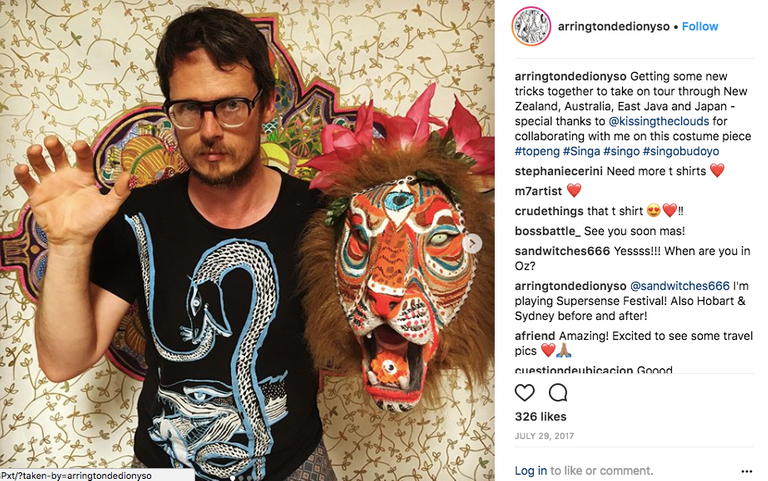
In many of Dionso's works, we see animal and human bodies interlaced, as well as humanoid figures with animal or monstrous faces. Sometimes it appears as if the figures are "transformed" into humanoids with animal (often cat) heads. Winkelman's criteria of both a special relationship with animals, and the belief that a Shaman transforms into animals, all seem to be strongly and repetitively represented in Dionyso's works.
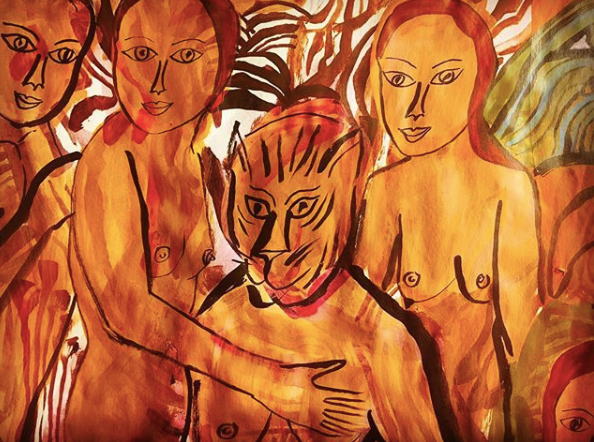
Dionyso also produced the following, explicit work which he tagged with #maskdance #maenads #birdmask, and which commenter labeled #Shamanicsexritual. In doing so, he mixes an orgy with standard ritual abuse imagery (masks) and shamanistic elements (animal-human identities). In using the Maenad tag, he directly references the ritualistic and often horrifically violent, even cannibalistic orgies and ecstatic rites of Dionysus so venerated by Michael Cornwall as discussed earlier in this piece.
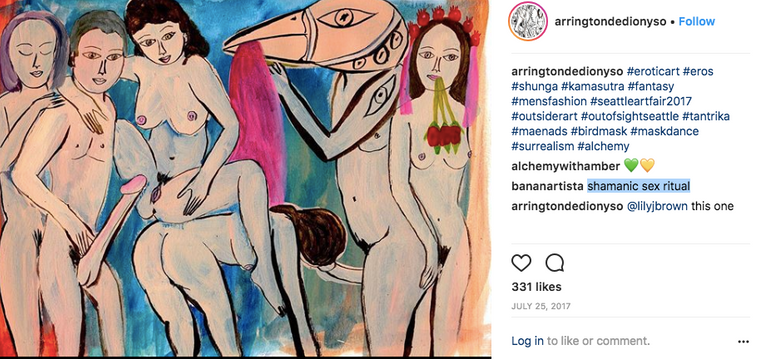
Dionyso also depicts humans with body parts in the shape of animal heads, usually genitalia or hands. The following image, published by Dionyso on his instagram account two days ago at the time of writing, has been named "Priapic Maenads," and tagged with phrases including #priapic #maenad #maenads #bacchantes. Hence this is not only a sexual image but is depicting a group of people in which Dionyso directly references the rites of Dionysus. The image is included here to illustrate a version of Winkelman's definition of shamanic traditions involving transformation into or identification with animals.
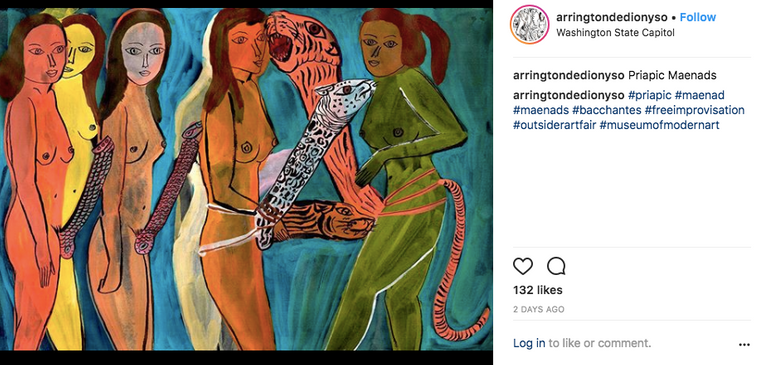
Continue on to the final article in this two-part series, here..
Another excellent and well researched article.
These people are sick.
Yes, they really do believe that doing these rituals will summon demons or other spiritual forces.
This really is a hard topic for many to take in, but it is very real.
The only criticism is to associate it to pizzagate; pizzagate has been taken to talk specifically about that one pizza place that is probably innocent. Although you did touch on that.
Keep up the good work.
Thank you!!
Curated for #informationwar (by @wakeupnd)
Our purpose is to encourage posts discussing Information War, Propaganda, Disinformation and other false narratives. We currently have over 7,500 Steem Power and 20+ people following the curation trail to support our mission.
Join our discord and chat with 200+ fellow Informationwar Activists.
Connect with fellow Informationwar writers in our Roll Call! InformationWar - Contributing Writers/Supporters: Roll Call Pt 8
Ways you can help the @informationwar
Also, check out our meme contest:
https://steemit.com/informationwar/@informationwar/memewar-contest-expose-the-msm-s-lies-on-president-trump-s-immigration-policy
Congratulations @whitedeer9217!
Your post was mentioned in the Steemit Hit Parade for newcomers in the following category:
I also upvoted your post to increase its reward
If you like my work to promote newcomers and give them more visibility on Steemit, consider to vote for my witness!
Appreciate it!